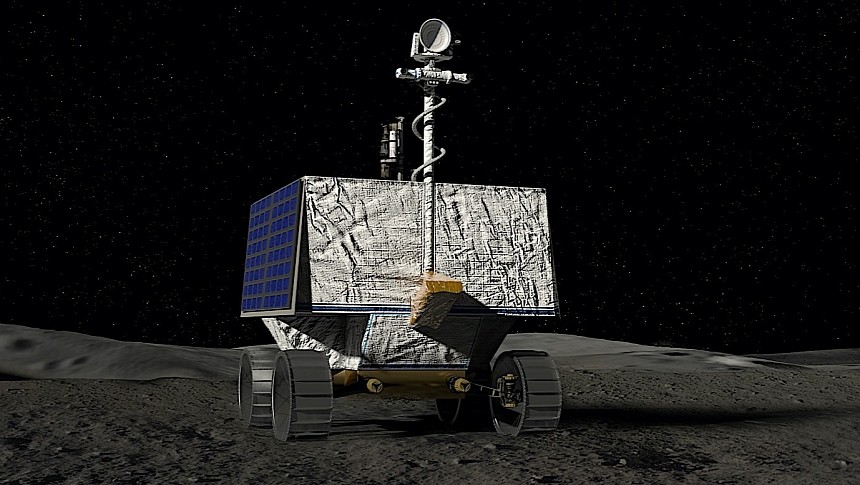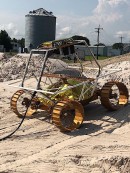2024 has just begun, but the eyes of space exploration enthusiasts are affixed to the end of the year, when some really impressive space missions will kick off. The most high-profile is, of course, Artemis II, which will circle the Moon with humans on board for the first time in decades. Another is the Volatiles Investigating Polar Exploration Rover, a tool that may really help make the Moon a second home for humanity.
The mission, which is called VIPER for short, has a simple yet potentially crucial goal in mind: find out how much water there is at the Lunar South Pole, opening the doors for future crewed missions to exploit it for their own goals.
NASA calls VIPER the "first resource mapping mission on another celestial body." Coincidentally or not, it is also the space agency's first-ever robotic Moon rover – that's right, for all its merits, and despite a wealth of such tools being sent to Mars, NASA has never sent a robotic explorer to the Moon yet.
The VIPER is the size of a golf cart (5 feet by 5 feet by 8 feet/1.5 meters by 1.5 meters by 2.5 meters), and weighs 992 pounds (450 kg). It looks like a metal box propped on four wheels, one that will use the 450 watts of peak power coming from its battery to drive head-on, but also sideways, diagonally, and spin in a circle without changing the way it's facing.
It will do all that in an attempt to point its three spectrometers at the most interesting portions of the lunar soil, as it seeks to find water in whatever form. When it does, it will use a 3.28-foot (1-meter) drill to dig into the surface and retrieve samples. It will then analyze them, and come up with data on the distribution, physical state and composition of ice deposits.
As 2023 was about to end, NASA gave us an update on how things are progressing with the rover. We learned the team behind the project is presently halfway through the build, and from now on the pace of the work should pick up.
Humans have installed all but one science instrument into the rover, and most of the key pieces of hardware that will go into the machine have already been acquired from vendors. That's a major step forward, considering the delays caused by supply chain issues dating back to the age of the pandemic.
NASA said the build so far was not without challenges. It had to overcome connector issues with vendor-supplied components, design issues, and even unexpected performance characteristics of some parts that had to somehow be accommodated into the design.
The team seems confident it'll be smooth sailing from now on, and looks forward to the unspecified date when testing the rover in lunar-like environments will begin – no date was announced for this milestone.
Just to give you a sense of how important the mission is to NASA, consider the fact a series of webchats, in both English and Spanish, are regularly being hosted (once a month) from the Johnson Space Center where the rover is being assembled.
NASA calls VIPER the "first resource mapping mission on another celestial body." Coincidentally or not, it is also the space agency's first-ever robotic Moon rover – that's right, for all its merits, and despite a wealth of such tools being sent to Mars, NASA has never sent a robotic explorer to the Moon yet.
The VIPER is the size of a golf cart (5 feet by 5 feet by 8 feet/1.5 meters by 1.5 meters by 2.5 meters), and weighs 992 pounds (450 kg). It looks like a metal box propped on four wheels, one that will use the 450 watts of peak power coming from its battery to drive head-on, but also sideways, diagonally, and spin in a circle without changing the way it's facing.
It will do all that in an attempt to point its three spectrometers at the most interesting portions of the lunar soil, as it seeks to find water in whatever form. When it does, it will use a 3.28-foot (1-meter) drill to dig into the surface and retrieve samples. It will then analyze them, and come up with data on the distribution, physical state and composition of ice deposits.
As 2023 was about to end, NASA gave us an update on how things are progressing with the rover. We learned the team behind the project is presently halfway through the build, and from now on the pace of the work should pick up.
Humans have installed all but one science instrument into the rover, and most of the key pieces of hardware that will go into the machine have already been acquired from vendors. That's a major step forward, considering the delays caused by supply chain issues dating back to the age of the pandemic.
NASA said the build so far was not without challenges. It had to overcome connector issues with vendor-supplied components, design issues, and even unexpected performance characteristics of some parts that had to somehow be accommodated into the design.
The team seems confident it'll be smooth sailing from now on, and looks forward to the unspecified date when testing the rover in lunar-like environments will begin – no date was announced for this milestone.
Just to give you a sense of how important the mission is to NASA, consider the fact a series of webchats, in both English and Spanish, are regularly being hosted (once a month) from the Johnson Space Center where the rover is being assembled.

















